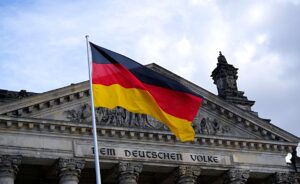
In 2025, Germany’s economy continues to face serious challenges. After two consecutive years of GDP decline (0.3% in 2023 and 0.2% in 2024), the current year is characterized by stagnation, with GDP growth forecast at 0.0%. This makes Germany the only G7 country that has not shown economic growth in the last three years.
The new government led by Chancellor Friedrich Merz, who is due to take office on May 6, is expected to present a package of measures to stimulate the economy. These include
Economists predict a moderate recovery of the German economy in 2026 with GDP growth of around 1.0%. However, the successful implementation of these forecasts will depend on the new government’s ability to effectively address internal and external challenges.

Germany topped the list of leading beer exporters to China in the first quarter of this year (by $23.258 million), according to the State Customs Administration (SCA) of the PRC.
It was followed by the Netherlands (by $11.799 million), Belgium (by $11.239 million), and Spain (by $10.028 million). Among Asian countries, Japan supplied the most beer to China – by $5.276 million.
In total, in January-March 2025, China imported beer from 52 countries and exported it to 89.

The Index of Economic Expectations of Investors and Analysts in Germany for the next six months, calculated by the ZEW Research Institute, fell to the lowest since July 2023 of minus 14 points in April from the highest since February 2022 of 51.6 points a month earlier. This is the most significant drop since March 2022. Analysts on average expected it to decline to 9.5 points in April, according to Trading Economics.
“Global uncertainty has increased dramatically, not only because of the possible effects of the [US] mirror duties on world trade, but also because of the dynamic nature of their changes,” said ZEW President Achim Wambach. ”This is especially affecting export-intensive industries such as the automotive and chemical industries, as well as the production of metals, machinery and steel, which have recently seen significant improvements.
Meanwhile, the indicator of attitudes toward the current situation in Germany increased to minus 81.2 points this month from minus 87.6 points in March.
In the eurozone, the index of economic expectations in April fell to the lowest since December 2022, minus 18.5 points from 39.8 points a month earlier. The experts’ forecast for this indicator was 14.2 points.
The indicator for assessing the current economic situation in the currency bloc decreased by 5.7 percentage points to minus 50.9 points.
Source: http://relocation.com.ua/index-ekonomichnyh-ochikuvan-investoriv/

Representatives of the CDU are concerned about the safety of Germany’s gold reserves in storage at the US Federal Reserve, Bild reports. In particular, the publication cites the opinion of Christian Democratic Union (CDU) MP Marco Vandervitz, who, according to Bild, unsuccessfully tried to inspect the gold reserves in 2012, trying to force the Bundesbank to either take on a more active role as custodian or repatriate them to Germany.
MEP Markus Ferber (CDU) also called for more thorough inspections of German gold stored in the United States.
“Bundesbank officials should personally count the bullion and document their results,” Bild quoted him as saying.
Germany has the second largest gold reserves in the world, and keeps 37% of them – about 1,236 metric tons worth 113 billion euros – in the vaults of the Federal Reserve System of New York. These reserves of the precious metal ensure that the Bundesbank will have access to what it can exchange for US dollars (or any other hard currency) if needed.
German politicians are concerned about both Trump’s tariff policy and his attempts to expand his powers and become above the US judicial system.
In February, Bundesbank President Joachim Nagel told Bild: “We have (…) no doubt that in the New York Fed we have a reliable partner for the storage of our foreign exchange reserves.”
The publication points out that concerns about the fate of gold have been exacerbated by “none other than billionaire and senior Trump administration official Elon Musk, who called for a review of the US’s own foreign exchange reserves.”

In 2024, the German residential real estate market faced a number of challenges, including falling prices, slowing construction and rising borrowing costs. Here are the key trends and forecasts for 2025, focusing on the country’s largest cities.
Decline in housing prices
In the first half of 2024, the average asking prices for new and existing apartments decreased by about 3.6% compared to the same period in 2023. This decline is less pronounced than in previous periods, when the drop reached 7.3% and 7.4%, respectively. The largest annual decline was recorded in Frankfurt am Main – by 6.5%, while in Hamburg the decline was only 0.6%.
The situation in major cities
Munich: The most expensive city in Germany with an average price of about 11,000 euros per square meter. In 2024, there was a 5.2% decline in prices for new buildings.
Berlin: The average housing price was around 7,920 euros per square meter.
Hamburg: A 5% decline in new construction prices, which is one of the smallest declines among major cities.
Frankfurt am Main: The largest year-on-year price decline of 6.5%.
Düsseldorf and Leipzig: On the contrary, these cities recorded an increase in prices for new buildings by 4.1% and 8.7%, respectively.
Housing shortage and construction activity
According to a study by the Federal Institute for Building, Urban and Spatial Research (BBSR), Germany needs to build 320,000 new apartments every year until 2030 to meet growing demand, boosted by the influx of immigrants from Ukraine and Syria. However, in 2024, only 216,000 apartments were authorized, the lowest number since 2010 and reflecting the real estate crisis.
Financial performance and investments
Germany’s largest real estate group, Vonovia, reported its third consecutive annual loss in 2024, amounting to EUR 962.3 million, due to significant write-downs in property values. Nevertheless, CEO Rolf Buch predicts a return to profitability in 2025, provided that real estate prices stabilize.
Forecast for 2025
German house prices are expected to grow by 3.5% in 2025, although there is a significant risk of weaker growth. The market continues to face difficulties due to high borrowing and construction costs. Rental growth is expected to exceed house price growth, making it difficult for potential buyers to save a down payment.
In general, the German residential real estate market in 2024 was characterized by declining prices and slowing construction activity. Forecasts for 2025 suggest a moderate increase in prices, but the market remains sensitive to economic and political factors.
Source: http://relocation.com.ua/analysis-of-residential-real-estate-market-in-germany/

The desire of Ukrainians who fled the war to stay in Germany even after the end of hostilities is linked to their increasing integration into German society, according to an analysis by the Institute for Research on the Labor Market and Professions (IAB). “The high level of education and strong desire to integrate among Ukrainian refugees create opportunities for both sides, especially given the demographic changes and the lack of qualified personnel in Germany,” said IAB expert Yulia Kosyakova.
However, for mutually beneficial relations to develop, Germany should be more active in helping Ukrainians find jobs, learn the language and recognize professional qualifications, Kosyakova said.
The IAB study shows that on average, only 22% of Ukrainian refugees aged 18 to 64 are employed. 57% of Ukrainian women and 50% of men work in Germany in positions that do not correspond to their qualifications. Most often, Ukrainians find work in the cleaning industry, catering, and social services, including care for people with disabilities. The average monthly gross income of Ukrainians working full-time is EUR 2,600, which is significantly lower than the average in Germany (EUR 4,479).
At the same time, according to the study, 97% of adult refugees have a school education, 75% have vocational or higher education, and 90% have work experience in their home country. Only 20% were able to officially confirm their diplomas and qualifications in Germany.
Source: http://relocation.com.ua/bilshe-polovyny-ukrainskykh-bizhentsi/